
Amazon Kindle Scribe
The Kindle Scribe offers Amazon’s best e-reader features in a larger form factor with pen support. The big 10.2-inch display is perfect for sketching, reading, and annotating books and PDFs. The version with the Premium Pen costs $30 more than the one with the Basic Pen, but is worth it for the eraser and extra button.
Stylus support and note-taking have been a long time coming on Amazon’s popular Kindle e-reader line-up. They’re finally here on the Kindle Scribe, along with the largest e-ink display in the series yet. The Kindle Scribe promises to be an excellent e-book reader but also a handy digital notepad and sketchpad. Does it live up to its potential? I spent one month reading books, sketching, jotting down thoughts, and solving math problems, to answer that question. So let’s see the verdict in Android Authority‘s Amazon Kindle Scribe review.
About this Amazon Kindle Scribe review: I tested the Amazon Kindle Scribe (16GB with Premium Pen) over a period of one month. The unit was provided by Amazon for this review.
What you need to know about the Amazon Kindle Scribe
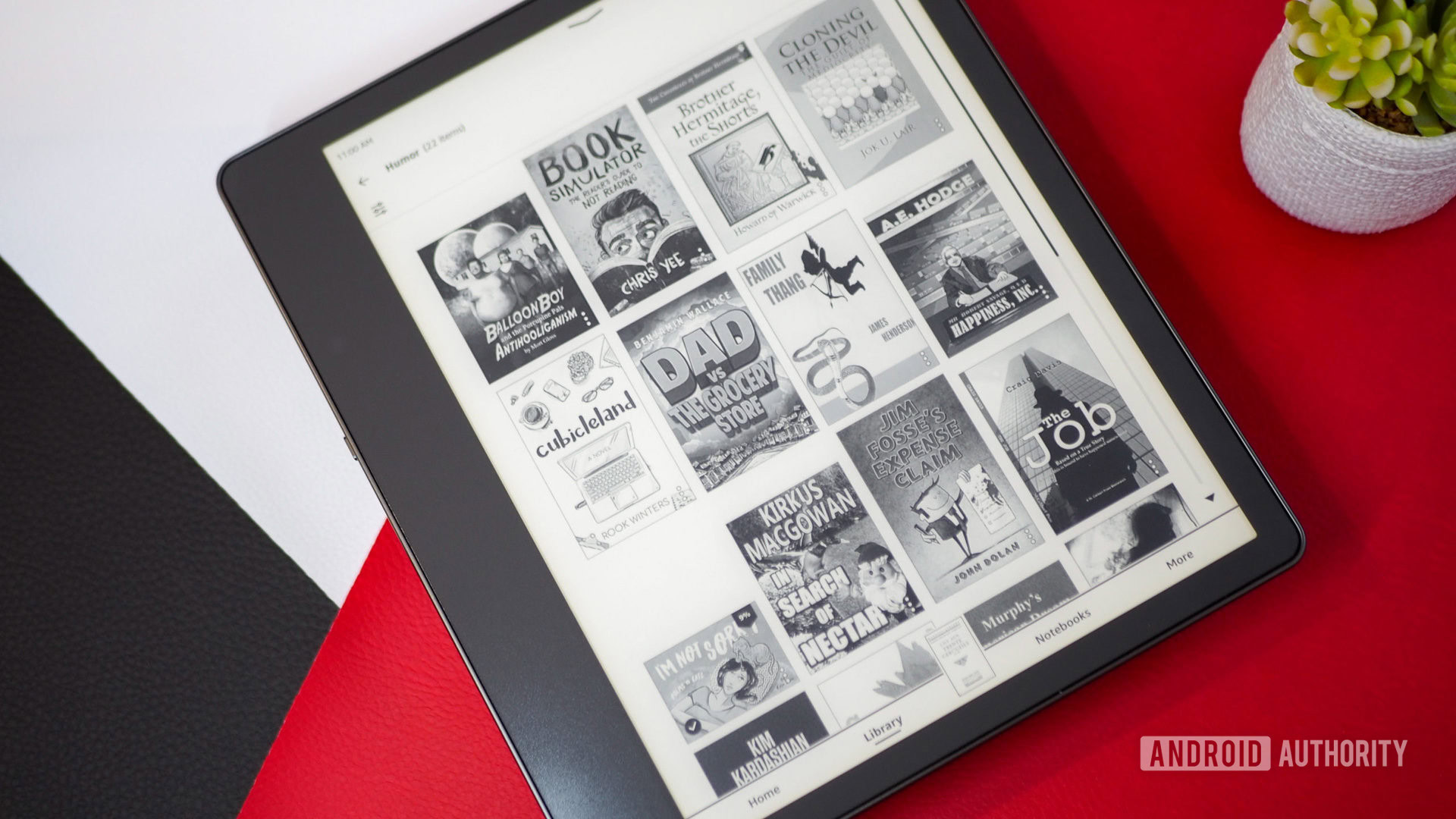
Rita El Khoury / Android Authority
- Amazon Kindle Scribe (16GB, with Basic Pen): $339.99 / €329.99 / £369.99
- Amazon Kindle Scribe (16GB, with Premium Pen): $369.99 / €359.99 / £399.99
- Amazon Kindle Scribe (32GB, with Premium Pen): $389.99 / €379.99 / £419.99
- Amazon Kindle Scribe (64GB, with Premium Pen): $419.99 / €409.99 / £449.99
The new Amazon Kindle Scribe touts the biggest display of any Kindle yet. At 10.2 inches with a 1,860 x 2,480 resolution (300ppi), the e-ink panel is not only large enough to accommodate books, comics, magazines, and PDFs, but it also serves as an excellent canvas for all of your sketching and note-taking needs. It’s flanked on one side with a larger bezel for better ergonomics, and you can rotate the display for right- and left-handed use.
The power button and USB-C port sit on the side, a seemingly awkward position at first, but one that makes sense as you use the Kindle Scribe for longer periods of time. Having the USB-C cable come out of the side means you can still rest the reader on your lap and read or write while it’s charging, without twisting or bending the cable. It still looks funky, though.
Amazon is offering two stylus options with the Kindle Scribe; both of them attach magnetically to the side, come with three extra nubs in the box, and don’t require any pairing or charging. They allow you to take standalone notes, annotate directly on top of PDFs, and take handwritten sticky notes in regular e-books. The Basic Pen does one thing only: write. The Premium Pen introduces a pressure-based eraser on the opposite end and a customizable button on the side.
This is the highest-end Kindle e-reader available today and the price reflects it. It’s $90 more expensive than the previous flagship Oasis (2019) and $200 more than the Kindle Paperwhite (2021). You can buy it directly from Amazon, obviously, but also from Best Buy in the US. The only color available is tungsten black.
What’s good?
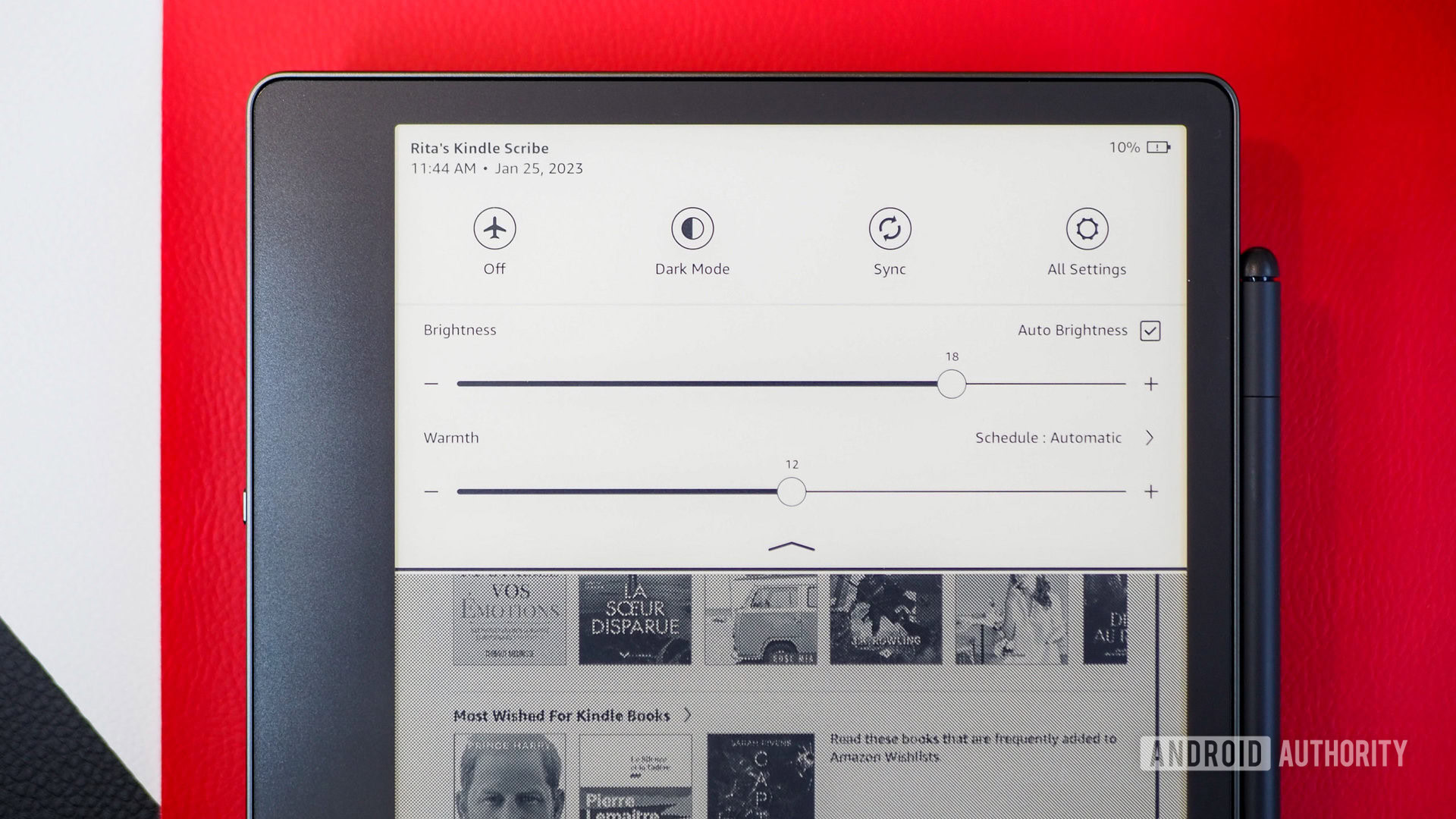
Rita El Khoury / Android Authority
The star of the show with the Kindle Scribe is its 10.2-inch e-ink glare-free display. It’s easy to read outdoors in direct sunlight, and the 35 LED lights make it suited for indoor use too. Like the Oasis (2019) and Paperwhite (2021), the Scribe can adapt its display’s brightness automatically and schedule its warmth changes to follow the local sunrise and sunset. It switches from a cooler tone during the day to a warmer color at night.
The Kindle Scribe’s display is almost the size of a sheet of A5 paper. It’s ideal for note-taking and sketching.
The display’s biggest asset, though, is its physical size. It has the approximate dimensions of an A5 sheet of paper, making it ideal for note-taking and sketching without being too unwieldy. Comic books, magazines, and PDFs are easier to parse on it than on any 6- or 7-inch Kindle.
In my month testing the Kindle Scribe, this is the feature I appreciated the most. I had previously tried and failed to read comic books, documents, and study books on other Kindle models. The displays were too small, text was painful to parse, and zooming in/out every two seconds was a frustrating experience. The Scribe is the first time I was able to actually read those books on a Kindle.
Writing on the Amazon Kindle Scribe is a pleasant experience, similar to the Huawei MatePad Paper. It’s as close as a digital display and stylus can get to the familiar pen-and-paper feel. Latency is unnoticeable; you immediately see every stroke.
The Premium Pen is worth the extra $30 if only for the eraser functionality. It’s super intuitive to flip it around to delete mistakes or bits you no longer need. The extra side button can be programmed to act as a highlighter, pen, eraser, or to add a sticky note in books. I recommend you set it up to highlight if you plan on studying or reading important documentation on the Scribe; it’s as if you had a secret Sharpie in your hand.
The Kindle Scribe’s Basic Pen can only write. The Premium Pen has two extra features: a pressure-based eraser tip on the opposite end and a programmable button on the side that can be used to highlight text or add sticky notes.
Like every other e-reader, the Kindle Scribe boasts excellent battery life. I only needed to top it up after three weeks of very active use (reading four full books, and taking many notes and sketches).
Amazon is also sensible enough not to display lock screen ads on the Scribe. At the price, it would’ve been very sleazy to see random books on the inactive display. Still, I’d love if we could disable all the random recommendations from the main home screen too.
What’s not so good?
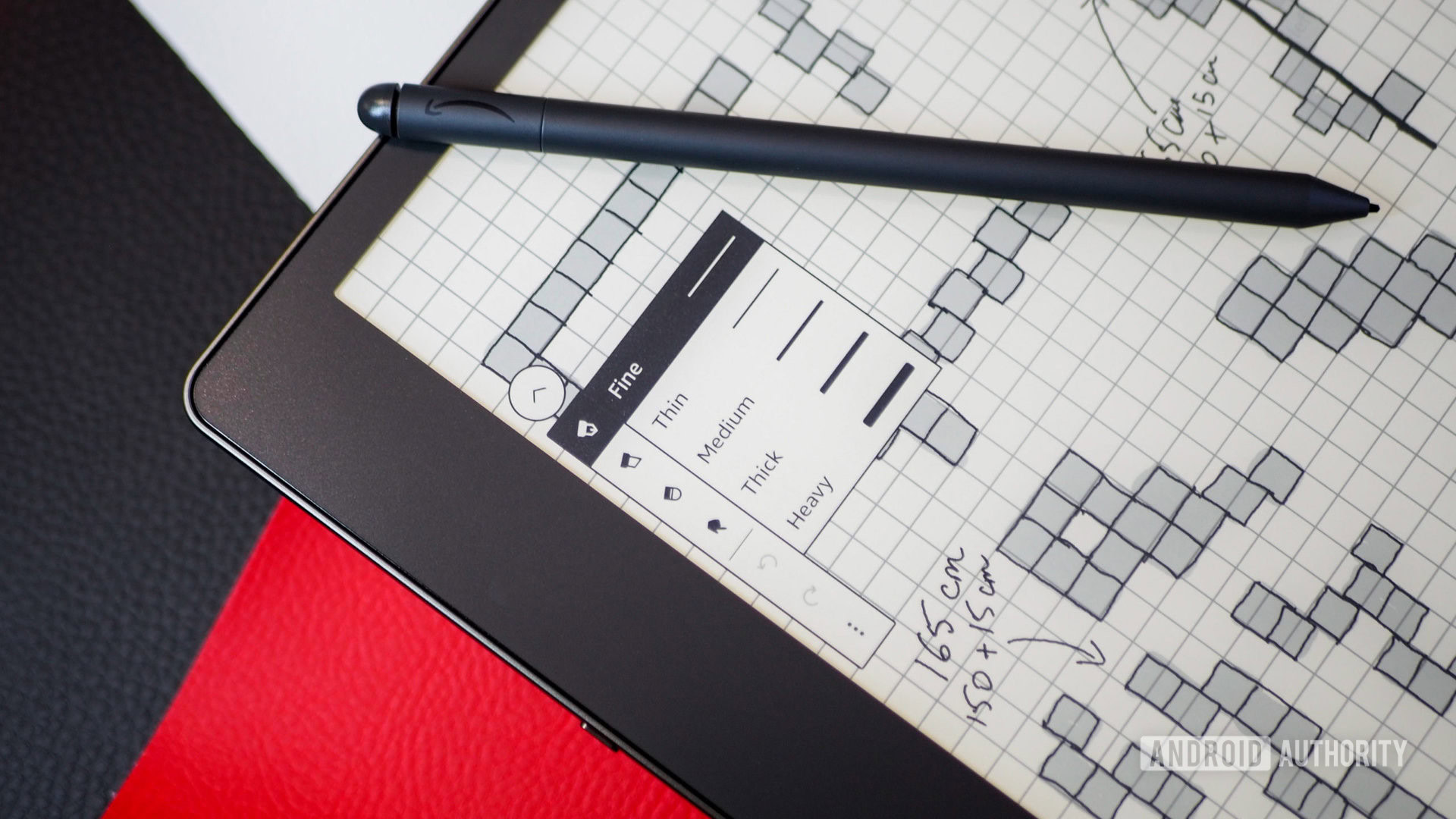
Rita El Khoury / Android Authority
For a first-generation Kindle with stylus support, the Scribe offers the absolute bare minimum of note-taking and sketching features. First, the pen doesn’t support variable tilt and pressure sensitivities. The stroke is the same, no matter how you hold it. Amazon has only implemented pen, highlighter, and eraser functions, each in five different stroke widths. You don’t get any more tools or brush types, but those are supposedly coming in a future update.
There are also zero gestures or smart functionalities associated with the pen. Unlike more advanced note-taking experiences like the iPad and Apple Pencil or reMarkable 2, you can’t select parts of your sketches to move or resize them. You can’t insert lines between text or spaces between characters, copy and paste bits around, or draw smart shapes. If you’re like me and you can’t draw a straight line to save your life, the Scribe won’t straighten it for you. Forget about rectangles or circles too. Handwriting recognition and OCR are nowhere to be found either.
The Kindle Scribe offers the absolute bare minimum note-taking, digital pen, and sketching features. Amazon says an update will add more.
Overall, this feels like digital note-taking 1.0, circa 2010. It’s exactly the same workflow as working with a real paper — zero smart advances for our modern digital age. Every time I picked up the pen to take notes, solve a math problem, or sketch something, I knew I was going to use the undo button or eraser way more than I intended. A simple thing like moving an item down one line in a list requires erasing the entire line and writing it again. Suffice it to say, this is far, very far from what you can do with a modern tablet or a digital notepad like the reMarkable or Supernote.
Export options are quite limited too. Basically, you can email anything as a PDF. Standalone notes also sync across your Kindle account and can be accessed in view-only mode via the Android and iOS apps — no editing. PDF annotations and handwritten sticky notes don’t sync to other devices yet. All of this hinders the usefulness of the entire note-taking experience.
But worse than that are all the confusing limitations around e-book formats and what you can or can’t do. See if you can follow the logic:
- You can’t directly download PDFs or EPUBs directly from the Scribe’s built-in browser. Only AZW, PRC, MOBI, or TXT extensions are supported. Other file types will have to be loaded using Send to Kindle. There’s nothing new here compared to other Kindles, but it’s an arbitrary limitation that makes less and less sense on a device that thrives on book reading and annotation.
- You can only scribble and directly annotate PDF documents. Any other format doesn’t allow this, but uses sticky notes instead. However, you can’t annotate PDFs loaded via USB-C or sent to your Kindle before 11/11/2022. Another arbitrary limitation.
- Sticky notes with typed or handwritten notes can be added to most Kindle Store or imported e-books in any format except PDF. However, Kindle Store mangas, comics, graphic novels, magazines, and newspapers don’t allow that for some reason. Also, see if you can find the sticky note icon in the above-right photo. It’s quasi-invisible.
- Since Amazon is phasing out MOBI support, you can’t add handwritten sticky notes or direct annotations to those.
The Kindle Scribe’s extension support is a mess. There are arbitrary limitations to what you can annotate or not.
In a few words: it’s a confusing mess. During my first week with the Scribe, I had no idea annotations, and sticky notes were possible because I was reading an old book in the MOBI format. It was only after I started reading other content that I realized I could sometimes attach a sticky note and sometimes directly write on the page. I had to dig online to find the distinction. Amazon needs to clarify this on the device, not on a support page no one will find, and it should remove some of these haphazard restrictions. A more consistent experience can go a long way.
The lack of water resistance is another very disappointing choice for the Kindle Scribe. If you thought we’d moved towards IP rating by default on all but the most basic Kindle reader, you’d be wrong. This $300+ model can’t handle water.
During my first week with the Scribe, I didn’t know about this downgrade; I just wrongly assumed it was water-resistant. So I placed it on the sink’s edge while washing my hands and propped it up in the kitchen while cooking several times. Nothing broke, but I’m glad I didn’t decide to take it into the tub or out in the rainy Parisian weather. Now that I’m aware of the limitation, I’ll baby it when I’m using it. It’s worth keeping this in mind if you’re looking for a pool-side or outdoor-friendly e-reader — you might be better off with something else.
Other downsides of the Kindle Scribe include its larger and heavier size, which could be annoying for longer reading sessions, and its pretty basic interface that requires multiple taps to switch between books, notes, and the browser. There are no page-turning buttons either, a beloved feature for any Kindle Oasis user.
Amazon Kindle Scribe review: The verdict
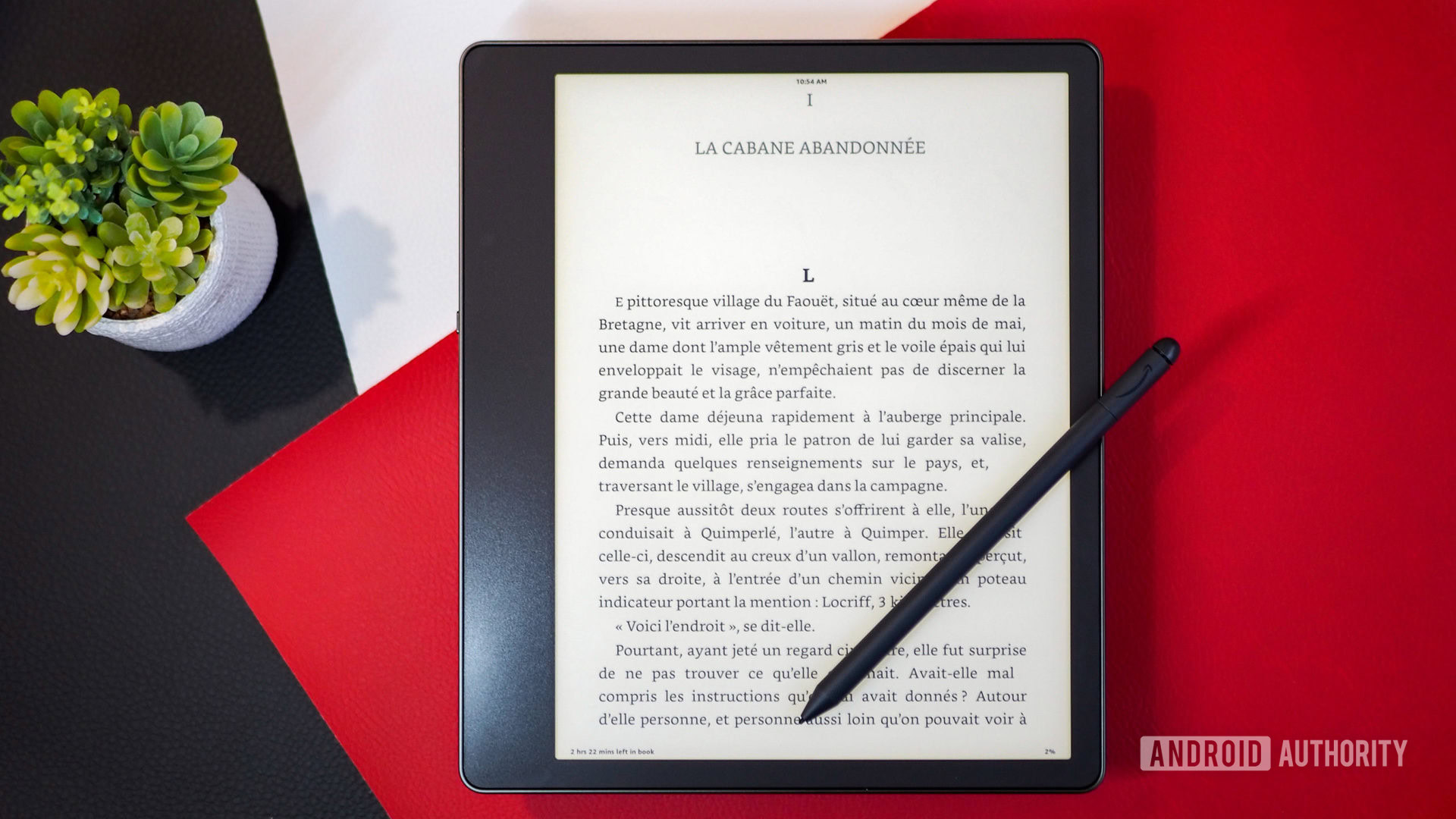
Rita El Khoury / Android Authority
The Kindle Scribe represents a big leap in Amazon’s e-reader line-up. For the first time, we can read documents, PDFs, and comics on a larger, more comfortable display, while also having the option to annotate and sketch. Save for the lack of water resistance, the hardware is exceptional too.
The software experience, however, is mediocre. Even if Amazon rushed the Scribe out to meet the 2022 holiday season, it still had years to develop a more robust note-taking experience. The limited pens and brushes, the absence of digital stylus gestures or features, and the lack of handwriting recognition are objectively inexcusable nowadays. Especially when other e-ink tablets offer them. Then there are the arbitrary and convoluted restrictions around the different book and document formats. Amazon is promising software updates with new features, though, and will likely drop the Scribe’s price many times over the course of the next months. Those would certainly make it more appealing.
The Kindle Scribe is an e-book reader first and foremost, with some basic note-taking features in tow. Don’t think of it the other way around.
As it stands, the Scribe is a bit of a unique beast in the e-reader market. It’s an e-book reader first and foremost, with some basic note-taking features in tow. If this is all you need, and you’re happy sticking to Amazon’s software experience, then by all means, go for it.
But if you want a better stylus experience and you know you’ll be jotting down notes and annotating documents more than reading books, you should look at the reMarkable 2 ($299) or Supernote (s$343). If you want a more open ecosystem with access to more Android apps, you’re better off with the Onyx Boox Note Air 2 Plus ($499.99) or the very high-end Onyx Boox Tab Ultra ($599) — or potentially the Huawei MatePad Paper (€499 at Huawei) if you don’t mind side-loading APKs.
Still, Amazon will probably sell an order of magnitude more Kindle Scribe units than any of these other companies, and is more likely to keep the Scribe updated for several years with new features. You get to decide what matters more to you.
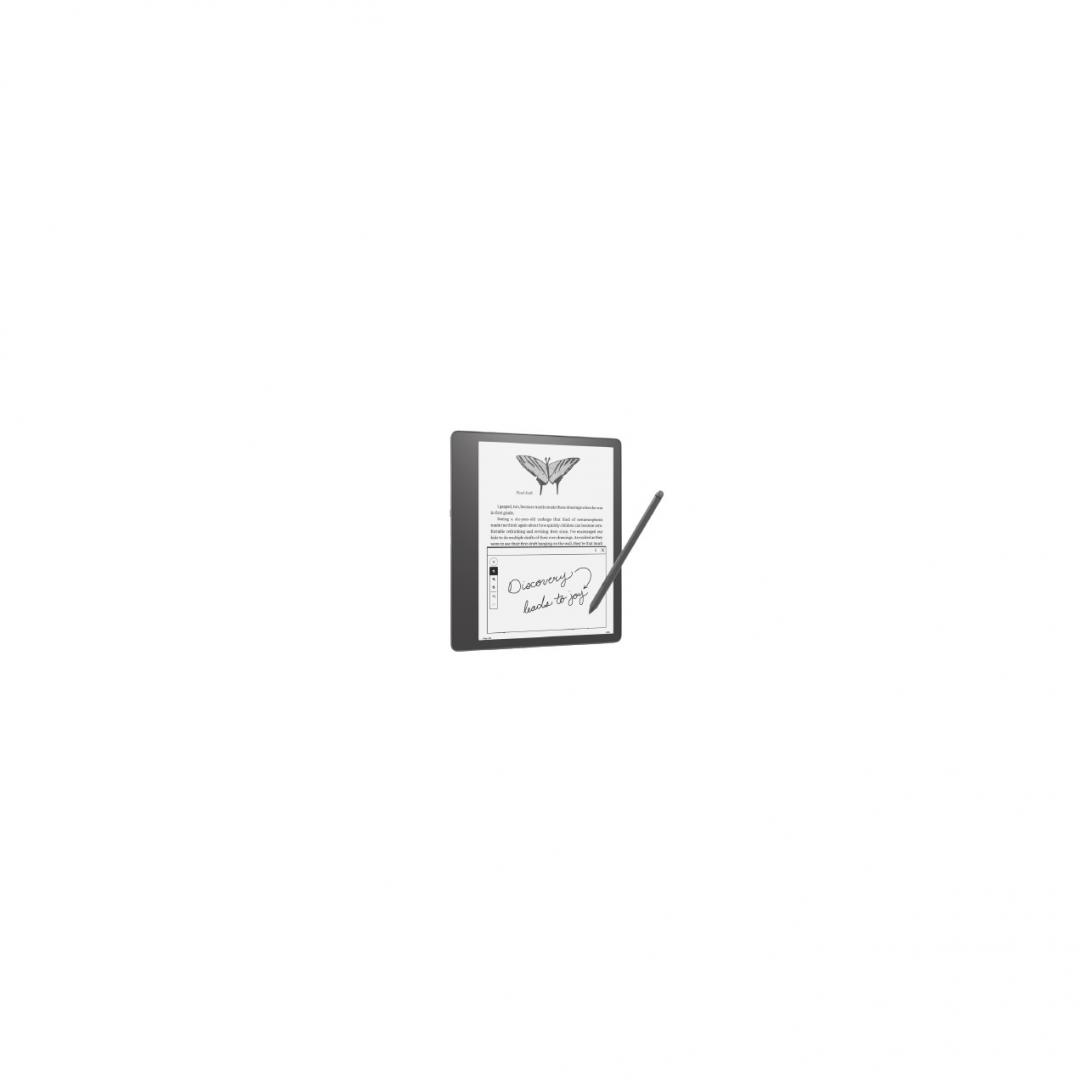
Kindle Scribe
E-ink writing • Included stylus • Incredible battery life
The Kindle Scribe is Amazon’s biggest e-reader yet, with pen support and note-taking capabilities.
The Kindle Scribe offers Amazon’s best e-reader features in a larger form factor with pen support. The big 10.2-inch display is perfect for note-taking and PDF annotation.
My personal take
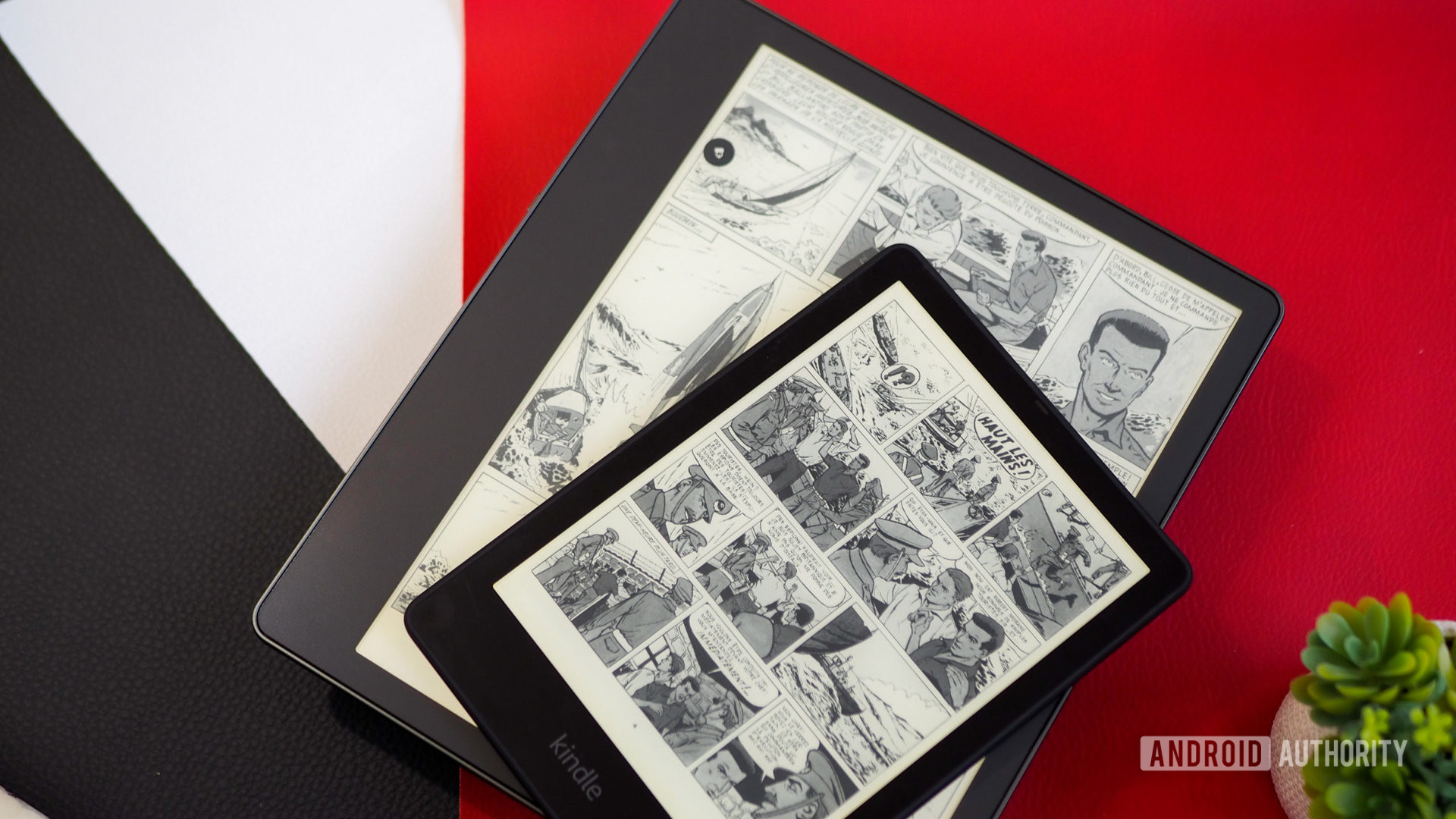
Rita El Khoury / Android Authority
It’s funny how an objectively frustrating device can also be one I am delighted to use every day. During my month with the Kindle Scribe, I found myself constantly wishing it could do more, because what it does now, it does so well, and I just love using it.
My aunt, a retired math teacher, and I have been challenging each other with high-school-level math problems and random enigmas and riddles for several weeks. It’s a nerdy way of staying in touch while living in different countries. Each time there’s a new problem, I just grab the Scribe and start solving away. It helps that I can erase and re-write multiple times and send her a clean copy, giving her the illusion that I solved it all in one go. Shhhhh, don’t tell her.
I also instinctively grabbed the Kindle Scribe when my husband and I were debating how to install the 13 Nanoleaf Canvas panels we got on the wall. After dozens of sketches over several days, we settled on one design and installed it. It only took a few weeks, but I don’t think about it anymore — this is my personal notepad now.
The Kindle Scribe is objectively frustrating in many ways. But can you love a disappointing product? Oddly, yes..
The Scribe won me over with those very simple use cases. Sure, it’s very basic digital note-taking, but it works for my current use case. Any extra features Amazon adds will be the cherry on top of that cake for me. E-book annotation, though, is a mediocre experience. The black-and-white display makes annotations barely distinguishable on top of PDFs, and the sticky-note icon is so tiny it’s impossible to spot. I’ve started highlighting text and adding a sticky note, just to make it more obvious.
Although I’ve finished four books on the Scribe so far, I still prefer the Kindle Paperwhite for regular e-books. I only read one word at a time, so a bigger display is pointless; the small Paperwhite is also nicer to hold for long periods of time.
The display does matter, though, when I’m opening documents, PDFs, or comics. The experience is leaps and bounds ahead of the smaller Kindle models. This does make me want a colored e-ink Kindle, though. We’re still far from that, but I really want to see study books and comic books in color.
More Kindle Paperwhite (2021) questions and answers
The Kindle Scribe only supports Wi-Fi 2.4GHz and 5.0GHz.
The Kindle Scribe is only available in Tungsten Black for now.
According to Amazon, the Kindle Scribe’s battery can last up to 12 weeks with half an hour of daily reading at medium brightness and with wireless turned off. For writing, this goes down to three weeks of half an hour of daily writing.
It takes 2.5 hours to fully charge the Kindle Scribe using a 9W USB-C wall charger.
No. The Amazon Kindle Scribe doesn’t have an IP rating, unlike other recent high-end Kindle e-readers.
No, the Kindle Scribe doesn’t support wireless Qi charging. You can only charge it with a USB-C cable.
Yes, the Kindle Scribe offers Bluetooth. You can connect a pair of headphones to listen to audiobooks from Audible.



